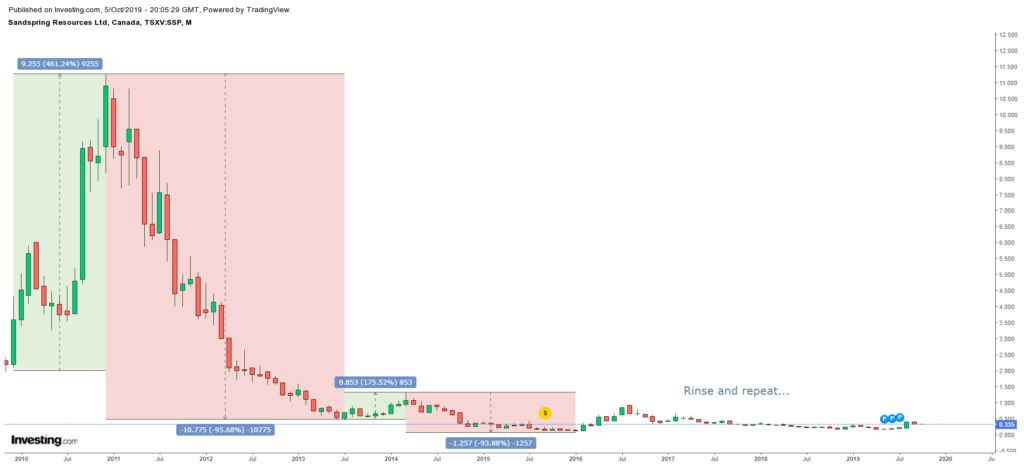Investing: The Importance of Exit Strategies & Value Forcing
When I started out investing in miners I bought a lot of “cheap” developers who had a lot of ounces in the ground. Some of these led to great returns during the epic 2016 rally in miners. Most of these later crashed back to where they started. More often than not these companies have created little value during the last couple of years but have probably diluted shareholders more than once over the same period. This is not what you want to see as an investor.
Nowadays I almost only invest in companies which I believe have credible exit strategies and/or value forcing capabilities.
What do I mean by that?
It basically means that a company has a fair chance of providing a natural exit for shareholders and/or can force the market to be “honest”. By natural exit strategies I am primarily talking about a junior being bought by a larger company. This in turn means that the company pretty much must have tier 1 or tier 2 potential, which is rare. What I mean by the ability to “force the market to be honest” is a company that is capable of developing assets themselves, which requires a well rounded team and good access to capital. In short, one either gets paid by an acquirer or one gets paid by the company itself through cash flow.
The opposite of these two criteria would be “optionality plays”. Usually this will be in the form of mature developers with a very large but very poor deposit(s). If an optionality play has no real way of either developing the project themselves nor has one of those rare projects that a larger company would want, then there is no natural exit for shareholder and no way of forcing the value of the company higher through cash flow either. This means that if we KNEW that none of these options were ever going to happen then all that is left for investors is to become traders or lose it all through inevitable dilution. Basically there is a big risk that the value of the optionality play position will decrease as a function of time.
With all of the above said, mature optionality plays can provide some of the best returns in the whole sector during a strong bull market. The problem is that no bull market lasts forever and if the asset(s) hasn’t been monetized in some way before the bull market is over, then these plays tend to crash the hardest and continuously dilute, while often not having advanced the project in any material way. These plays can be great from management’s stand point who might just want to dangle the deposit as a carrot for retail investors, raise money again and again, thus keeping their salaries without actually creating any value to speak of.
We also have the companies that does not fit the “mature optionality play” description, since they do not have a very large but poor quality deposit, but perhaps have a small deposit with a) No way of funding it, b) no way of growing it, c) no way of increasing its quality, and thus c) no way of pushing the project over a critical threshold which would make it attractive for either financiers nor potential acquirers. This description fits a lot of juniors which have some gold but nothing seems to happen. These will almost always inevitably lead investors to mass dilution and forcing investors to become greater fool traders since there are no natural exits or value forcing catalysts on the horizon.
Examples of mature optionality plays: Bear Creek Mining and Sandspring Resources.
- Long term chart of Sandspring Resources:
The above chart is a textbook example of a mature optionality play. Sandspring’s flagship project is a 10Moz behemoth located in Guyana. The company has hung around for many years but does not seem to have the ability to push it forward themselves nor has it been acquired by a larger company. Instead it has traded up and down with the ups and downs of the price of gold while continuously dilute shareholders. It becomes obvious when you look at the graph and see smaller and smaller jumps. During the one of a kind 2016 rally, the share price wasn’t even able to surpass the high of 2014. This is primarily because the share count has grown tremendously in between.
So what if there is only a 10% chance that the company will get bought or that they will be able to build it themselves?
Well, then investors run a 90% risk of having to be traders and hope to sell to greater fools before their piece of the company gets diluted down to nothingness.
Since I am not a good trader and prefer being a long term investor, because I think taking a long term view is the best way to capture alpha, I therefore try to stay away from mature optionality plays. I also try to stay away from projects that are too small, too poor and/or where I believe the people involved are incapable of developing the asset(s) due to lack of competence and/or lack of access to capital.
This also means that I have a hard time getting myself to buy base metal juniors since even if a company is successful in finding a decent to good deposit, the CAPEX will often be so big that most juniors will have a very hard time developing it themselves. Arizona Mining would be one rare exception that springs to mind. I think this is a major reason for why most zinc developers are trading for peanuts. The market is well aware that there is almost no chance of a given zinc junior to create their own destiny and force value (reach cash flow).
Also keep in mind that take-over are very rare so just going by the numbers means that if you hold say 10 different developers and expect that they will all get bought, then you are probably fooling yourself big time and will, again, be forced to be a trader or get diluted to nothingness.
So in light of all this, lets look at some companies to show you what I mean:
Liberty Gold
- Great access to capital
- Great people involved who have done it before (both selling and building)
- Potential tier 2 or tier 1 asset in Black Pine
… Therefore I believe there is a chance of a natural exit or value forcing
Lion One Metals
- Shown to have great access to capital and is cashed up
- CEO who is a serially successful mine builder with a lot of skin in the game
- Tier 1 potential
… Therefore I believe there is a chance of a natural exit or value forcing
Orca Gold
- Great access to capital
- Great people involved who have done it before (both selling and building)
- Tier 2 asset but located in a jurisdiction which is perceived to be very poor
… Therefore I believe there is a chance of a natural exit and value forcing capabilities
Novo Resources
- Lots of cash, great access to capital and possibly low CAPEX projects
- Great people involved
- Immense exploration potential in #2 jurisdiction in the world
… Therefore I believe there is a chance of a natural exit but especially value forcing capabilities
Minera Alamos
- Good access to capital and possibly low CAPEX projects
- Great people involved who have built similar mines before
- Good exploration potential
… Therefore I believe there is a chance of a natural exit but especially value forcing capabilities
TriStar Gold
- Good access to capital and possibly low CAPEX projects
- Good people involved who have had previous success
- Great exploration potential
- Vote of confidence from Royal Gold which suggests it is a project which should interest larger companies
- Reasonable CAPEX which means that building it themselves is not out of the question
… Therefore I believe there is a chance of a natural exit and value forcing capabilities
Irving Resources
- Good access to capital and possibly relatively low CAPEX projects
- Great people involved and backed by Newmont
- Tier 1 exploration potential in a good jurisdiction
… Therefore I believe there is a chance of a natural exit and value forcing capabilities
Honorable mentions: Osino Resources, Integra Gold & Bluestone Resources etc
These are just a few examples to show you what I mean. All of the above names could be considered to be real HODL candidates because company specific factors makes it plausible that they will either get bought or develop their assets themselves in the future. The fact management in all companies have serious skin in the game further points to this being the case.
To give you two examples of a successful natural exit and a value forcing, I would point to Ross Beaty’s Lumina Copper and Pan American Silver. The former had large high-capex copper projects BUT was able to sell pretty much the entire portfolio to larger companies. The latter had big silver deposits and was able to develop the projects internally and is today one of the largest silver producers on earth. This is why high-quality management and access to capital is so important and also why so many people are comfortable HODL:ing companies where the likes of Ross Beaty or say the Lundins are involved.
The main point of this article is that I would urge long term investors that before you purchase a stock that is supposed to be held for the long term (HODL), make sure that it fits one but preferably both of these criteria:
- Real objective tier 1 or tier 2 potential
- Management has the competence and access to capital which would allow them to develop the project if need be
… Else risk being forced to trade (successfully) in order to not see your position diluted to nothingness over time
(Note: This is not a buy or sell recommendation. This is not investment advice and I am not a geologist. This article is highly speculative and I can’t guarantee accuracy. I can’t guarantee the accuracy of the content in this article. Always do your own due diligence. I own shares of Novo Resources, Lion One Metals, Irving Resources, Liberty Gold, Orca Gold and TriStar Gold which I have bought in the open market and am thus biased. Novo Resources, Lion One Metals and TriStar Gold are passive banner sponsors. )
Best regards,
The Hedgeless Horseman
- Follow me on twitter: https://twitter.com/Comm_Invest
- Follow me on CEO.ca: https://ceo.ca/@hhorseman
- Follow me on Youtube: My channel




























